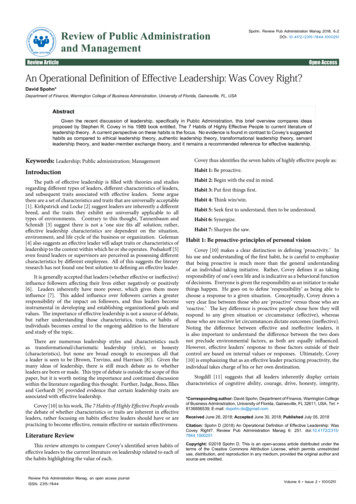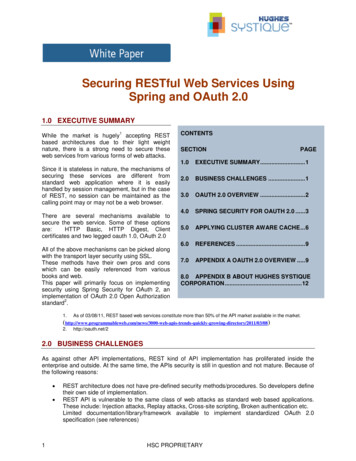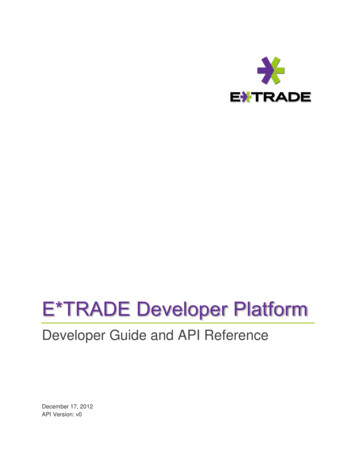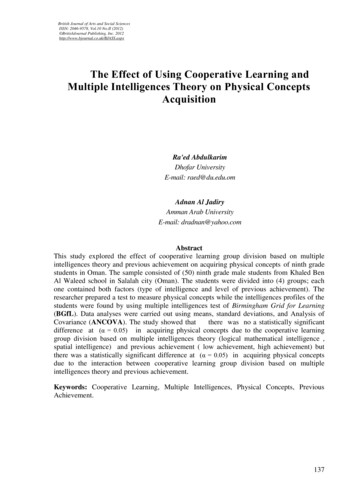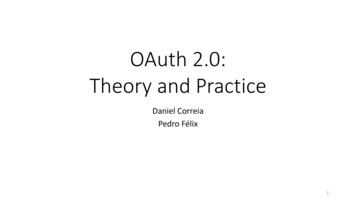
Transcription
OAuth 2.0:Theory and PracticeDaniel CorreiaPedro Félix1
whoami Daniel Correia Fast learner Junior Software Engineer Passionate about everything Web-related Currently working with the SAPO SDB team Pedro Félix Teacher at ISEL – the engineering school of the Lisbon Polytechnic Institute Independent consultant working with the SAPO SDB team2
OAuth History OAuth started circa 2007 2008 - IETF normalization started in 2008 2010 - RFC 5849 defines OAuth 1.0 2010 - WRAP (Web Resource Authorization Profiles) proposed byMicrosoft, Yahoo! And Google 2010 - OAuth 2.0 work begins in IETF 2012 RFC 6749 - The OAuth 2.0 Authorization Framework RFC 6750 - The OAuth 2.0 Authorization Framework: Bearer Token Usage3
An use case The cast of characters www.storecode.example – code repository service (e.g. github.com) www.checkcode.example – code analysis service (e.g. travis-ci.org) Alice – a fictional developer The problem How can Alice allow checkcode to access her private code stored at storecode?build and analyze codeAlicewww.checkcode.examplestores private codewww.storecode.examplefetch Alice’s code4
The password anti-pattern A solution: Alice shares her password with checkcode Problems: Unrestricted access – checkcode has all of Alice’s permissions read and write on all code repositories, issues, wiki, . No easy revocation Changing password implies revoking all other client applications Password management Changing password implies updating all the delegated applications5
The authorization requestAlice’s authentication and authorization delegation to checkcodeauthorization responsecodetoken requesttoken responseservice requestclient credscodeaccess tokenaccess tokenservice response Alice’s resource representation6
A demo would be niceAccessing GitHub7
Developer experience Manage Clients (Applications) client id client secret redirect uri8
User experience Grant authorizations Manage authorization9
The OAuth 2.0 ource Owner(aka User)authorizationClientrequestAlice’s authentication and authorization delegation to checkcodeauthorization responsecodeAuthorization Servertoken requesttoken responseservice requestclient credscodeaccess tokenaccess tokenservice response Alice’s resource representationResource Server (aka Service)10
A matter of icecheckcodestorecode11
Client Types Confidential“Clients capable of maintaining the confidentiality of theircredentials”(e.g. client implemented on a secure server) Public“Clients incapable of maintaining the confidentiality of theircredentials”(e.g. clients executing on the device used by the resourceowner)
Client Types 3 implementation scenarios Single client – all the users (web app) One client per user (native mobile app) One client per multiple users (family shared tablet, IPTV Box) Dynamic Client Registration Client Registration Endpoint – still in draft Turning public clients into private client instances Not a closed problem
Authorization and Token eFront Channelauthorization requestAuthorizationEndpointAlice’s authentication and authorization delegation to checkcodeauthorization responsecodeAuthorization Servertoken requesttoken responseclient credsaccess tokencodeTokenEndpointBack Channel14
Front and back channels Front channel Authorization Endpoint (AE)Authorization request – redirect from Client to AE via the User-agentHuman interface – User authentication and authorization delegationAuthorization response – redirect from AE to Client via the User-agent Back channel Token Endpoint (TE)Direct request-response between Client and TENo User interactionNo human interface15
Scopes scope “scope of the access request” Parameter on the authorization request or token request Set of space-delimited strings E.g https://www.googleapis.com/auth/calendar.readonly Usages Client – Must find the required scopes for each service interaction – docs User – AS translates the scopes into friendly User messages Service – Maps a scope into (URIs, methods) or (service, operation) Granted scope may differ from requested scopes No provision for mandatory and optional scopes16
The grant concept Represents the logical outcome of the User’s authorization User identity Client identity Scope Core domain concept Bound to all the tokens Code Access token Refresh token17
Not (Keep It Simple)18
OAuth 2.0: a framework not a protocol The previous protocol is just a one of many options Three parts1. Obtaining user authorization2. Issuing access tokens3. Using access tokens to authorize service requests Multiple protocol flows Different User authorization Critique Complexity Compromises interoperability WS-* again?19
Obtaining authorization Authorization Code Grant The previous protocol Implicit Grant Authorization Endpoint returns the access token directly Javascript Clients running on the browser Resource Owner Password Credentials Grant User gives password to Client, Client uses it to obtain access token Client Credentials Grant No User, Client access on its own behalve Extensions Identity federation, SAML assertions20
Implicit GrantJavascript Client on browserwww.storecode.exampleauthorization requestAlice’s authentication and authorization delegation to checkcodeauthorization response access tokenservice requestaccess tokenservice response Alice’s resource representation21
Resource Owner Password Credentials nt accessUser passwordtoken requesttoken responseservice requestclient credsUser passwordaccess tokenaccess tokenservice response Alice’s resource representation22
Client Credentials en requesttoken responseservice requestclient credsaccess tokenaccess tokenservice response Alice’s resource representation23
Accessing the Token EndpointPOST /token endpoint HTTP/1.1Host: as.storecode.exampleContent-Type: application/x-www-form-urlencodedAuthorization: Basic client id:client secret grant type authorization codecode AbCdEf.redirect uri https://redirect.checkcode.exampleclient id .&client secret .HTTP/1.1 200 OKContent-Type: application/json;charset UTF-8Cache-Control: no-storePragma: no-cache{"access token":"2YotnFZFEjr1zCsicMWpAA","token type":"Bearer","expires in":3600,"refresh token":"tGzv3JOkF0XG5Qx2TlKWIA","example parameter":"example value"}24
Accessing the service (Resource Server) How to associate the access token to the request message? Bearer – just append the token to the request message – RFC 6750 Just like “bearer checks” or HTTP cookies MAC (holder-of-key) – prove the possession of a key – still draft Similar to OAuth 1.0 or to AWS (used in S3)GET /resource HTTP/1.1Host: api.storecode.exampleAuthorization: Bearer access token GET /resource HTTP/1.1Host: api.storecode.exampleAuthorization: MAC id “.”,nonce “.”,mac “.”25
Bearer vs. MAC Bearer Simpler – no signatures Require HTTPS Incorrect use RFC 6750 Similar to cookie usage Behare of the fallacy Same origin policies Discoverability MAC Safer More complex – signature Client library integration26
Token structure Not covered by the RFCs Token content options Artifact (reference/handle) – reference to stored data Store Hash(artifact) and not artifact directly At least 128 bits of entropy Revocation – just clear the stored data Assertions – contains the (cryptographically protected) data JWT – JSON Web Token Revocation – harder (e.g. maintain revocation list) Token data Validity periodGrant (User, Client, Scopes)Type ({code, access token, refresh token})Usage (e.g. code should be used only once)27
Refresh tokens Two lifetimes Access tokens – short lifetime Bearer usage Refresh tokens – long lifetime Usage requires client credentials Useful for revocation Token Endpoint - obtain new access token given a refresh token Critique: state management on the client28
Security: authorization uthorization request: response type code, client id, redirect uri, scope, stateAlice’s authentication and authorization delegation to checkcodeauthorization response: code, state Request-response correlation state parameter - unpredictable Session-fixation attack Code search At least 128 bit of entropySmall usage period (e.g. 5 minutes)Code bound to a client idCode usage throttled by client id29
Security: code authorization request: response type code, client id, redirect uri, scope, stateAlice’s authentication and authorization delegation to checkcodeauthorization response: code, .token request: client secret, redirect uri, code, .token responseaccess token30
Mobile: authorization uthorization request: response type code, client id, redirect uri, scope, stateAlice’s authentication and authorization delegation to checkcodeauthorization response: code, state Use a “web view” e.g. Windows 8 WebAuthenticationBroker Use an external browser - how to obtain the response parameters? Redirect Use localhost Special redirect URI urn:ietf:wg:oauth:2.0:oob (Google uses it but not on RFC) Custom redirect URI scheme31
OAuth 2.0: for authorization not authentication Not safe for authentication in the general case OpenID Connect – OAuth 2.0 authenticationcodeFacebook ASaccess tokenaccess tokenFacebook Clientaccess tokenalice@wonderla.ndFacebook APIimpersonationaccess tokenAnotherFacebook Clientaccess tokenalice@wonderla.ndFacebook API32
SDB - Service Delivery Broker Brokering between service clients and service enablers(implementations) Access Control (OAuth 1.0, API keys, .) Caching, protocol and format translation, . Public market place - https://store.services.sapo.pt Multi-tenantOAuth 2.0Service ClientsService ClientsService ClientsSDB Connecthttps://services.sapo.ptService Delivery Broker(SDB)Service EnablersService EnablersService Enablers33
References IETF Web Authorization Working Group - http://datatracker.ietf.org/wg/oauth/ RFCs Drafts Eran Hammer OAuth 2.0 and the Road to Hell - ad-to-hell/ OAuth 2.0 - Looking Back and Moving On - http://vimeo.com/52882780 John Bradley - -is-not-falling.html34
2010 - WRAP (Web Resource Authorization Profiles) proposed by Microsoft, Yahoo! And Google 2010 - OAuth 2.0 work begins in IETF 2012 RFC 6749 - The OAuth 2.0 Authorization Framework RFC 6750 - Th




